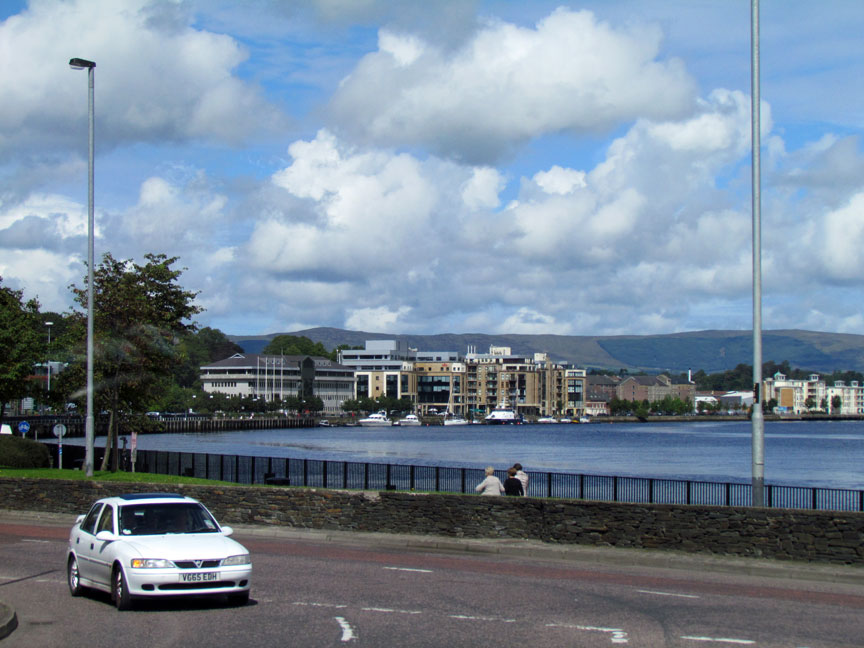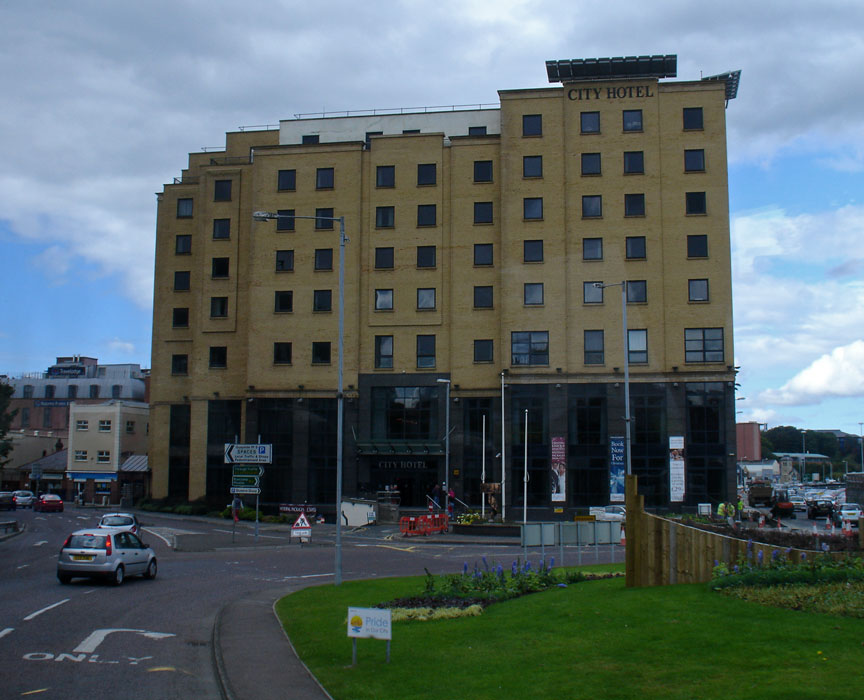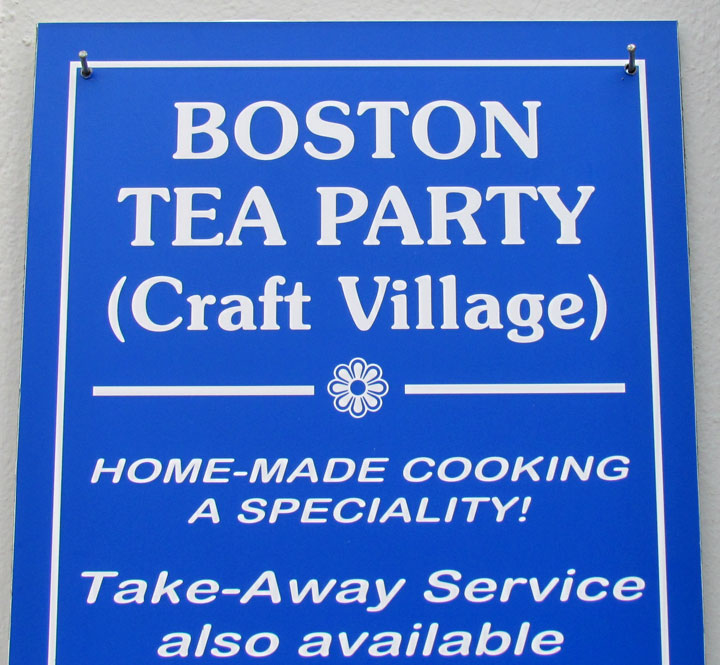

Londonderry
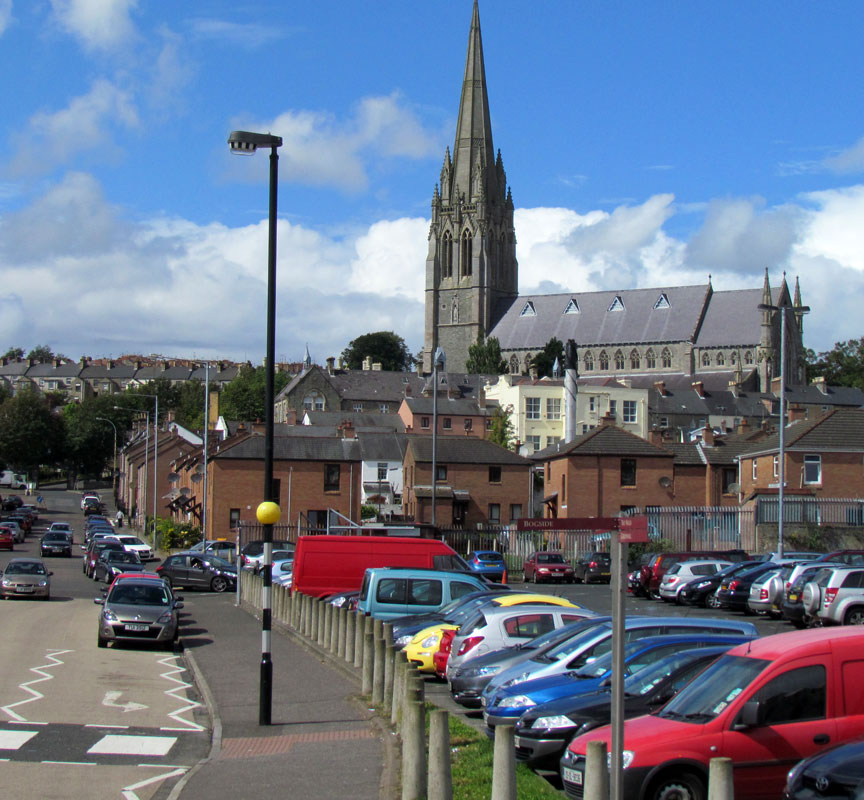
Londonderry
Derry or Londonderry is the second-biggest city in Northern Ireland and the fourth-biggest city on the island of Ireland. The name Derry is an anglicisation of the Irish name Doire or Doire Cholmcille meaning "oak-wood of Colmcille". In 1613, the city was granted a Royal Charter by King James I and the "London" prefix was added, changing the name of the city to Londonderry. While the city is more usually known as Derry, Londonderry is also used and remains the legal name.
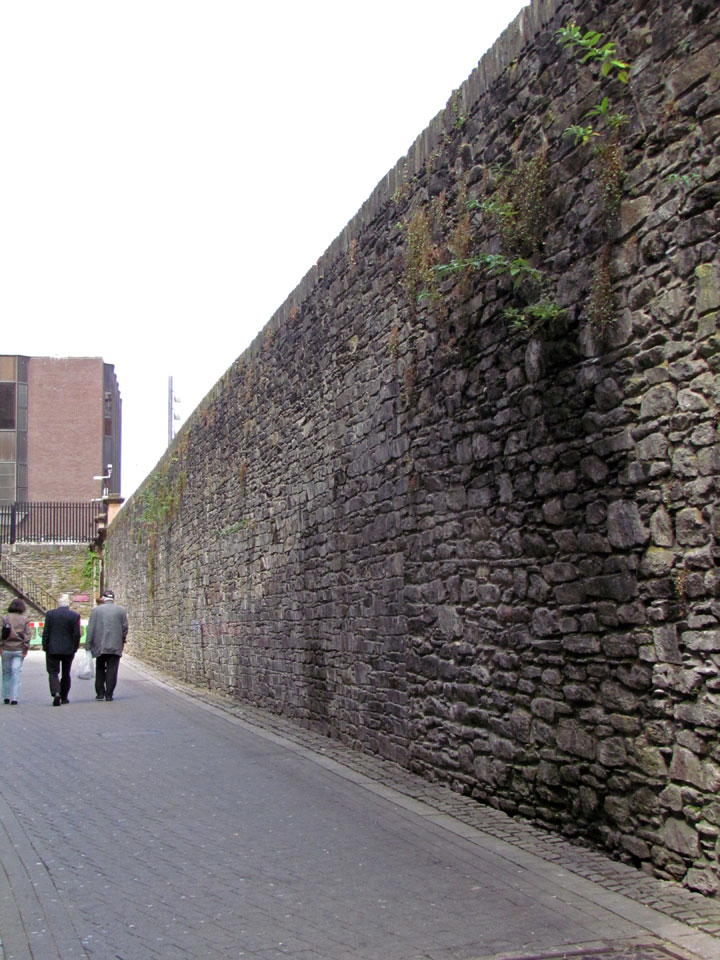
city wall
The old walled city lies on the west bank of the River Foyle, which is spanned by two road bridges and one footbridge. The city now covers both banks (Cityside on the west and Waterside on the east). The city district also extends to rural areas to the southeast. The population of the city proper (the area defined by its 17th century charter) was 83,652 in the 2001 Census, while the Derry Urban Area had a population of 90,663. The Derry City Council area had a population of 107,300 as of June 2006. The district is administered by Derry City Council and contains both Londonderry Port and City of Derry Airport.
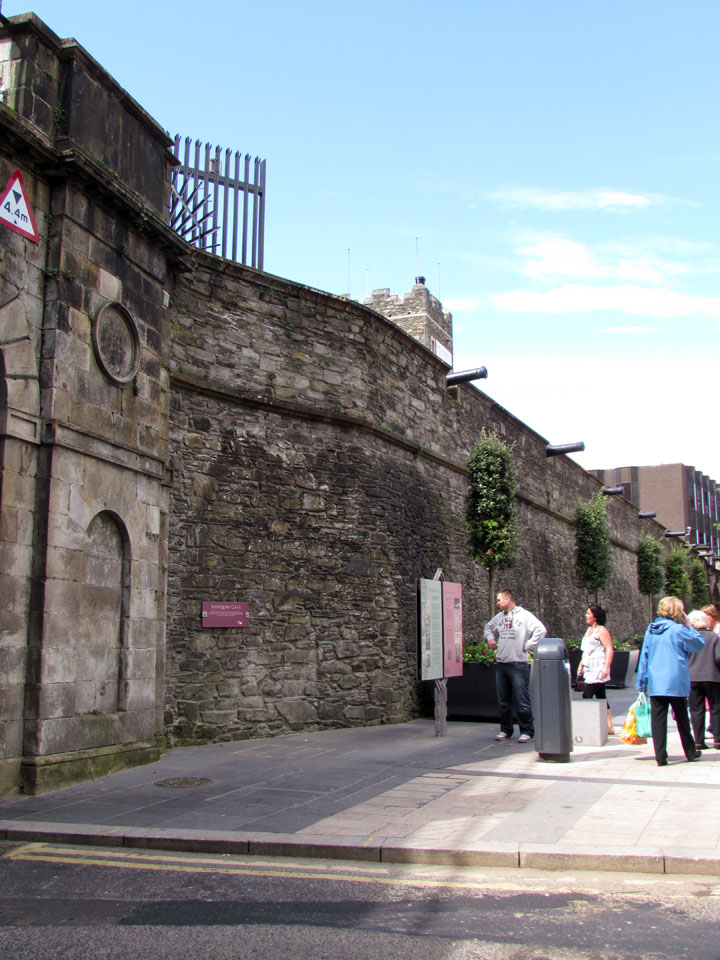
The Greater Derry area, that area within about 20 miles (32 km) of the city, has
a population of 237,000. This comprises the districts of Derry City and parts of
Limavady district, Strabane district, and North-East Donegal.
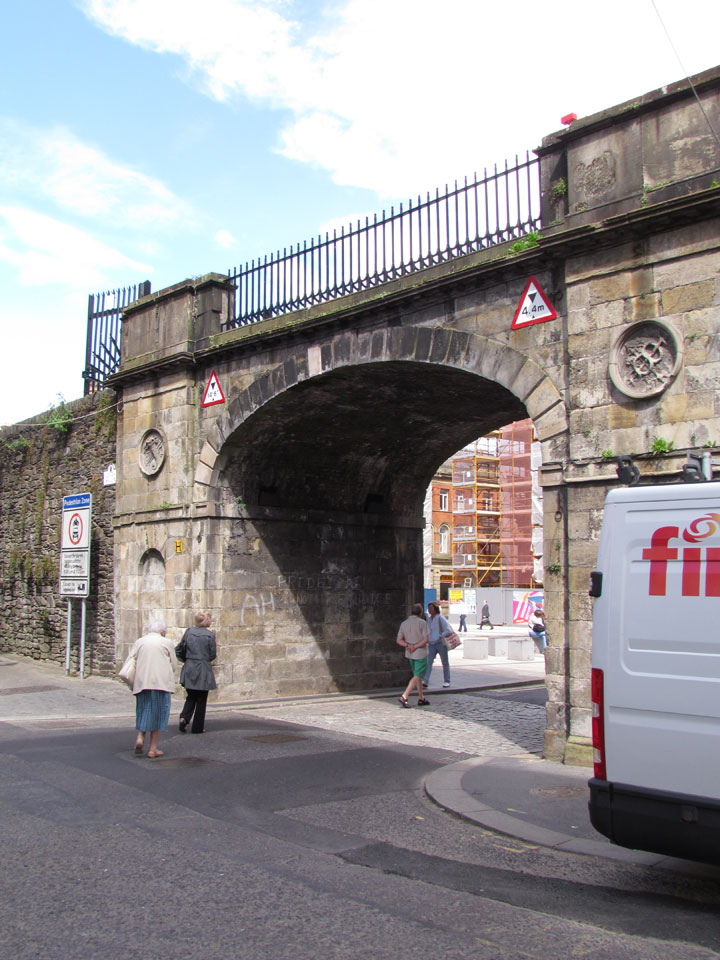
Derry is close to the border with County Donegal in the Republic of Ireland,
with which it has had a close link for many centuries. The person traditionally
seen as the 'founder' of the original Derry is Saint Colmcille, a holy man from
Tír Chonaill, the old name for almost all of modern County Donegal (of which the
west bank of the Foyle was a part before c. 1600). Derry and the nearby town of
Letterkenny form the major economic core of north west Ireland.
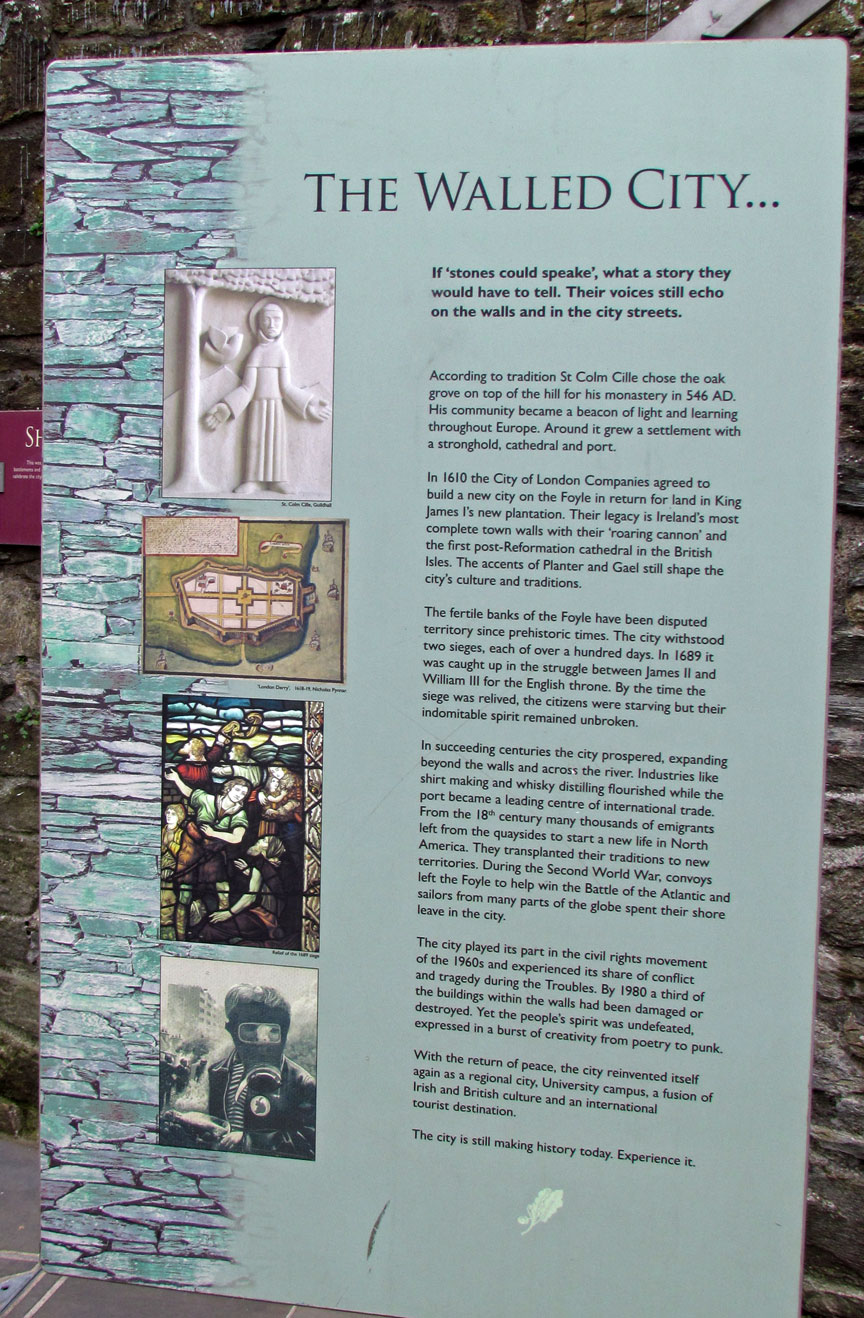
In 2013, Derry will become the first city to be designated UK City of Culture,
having been awarded the title in July 2010.
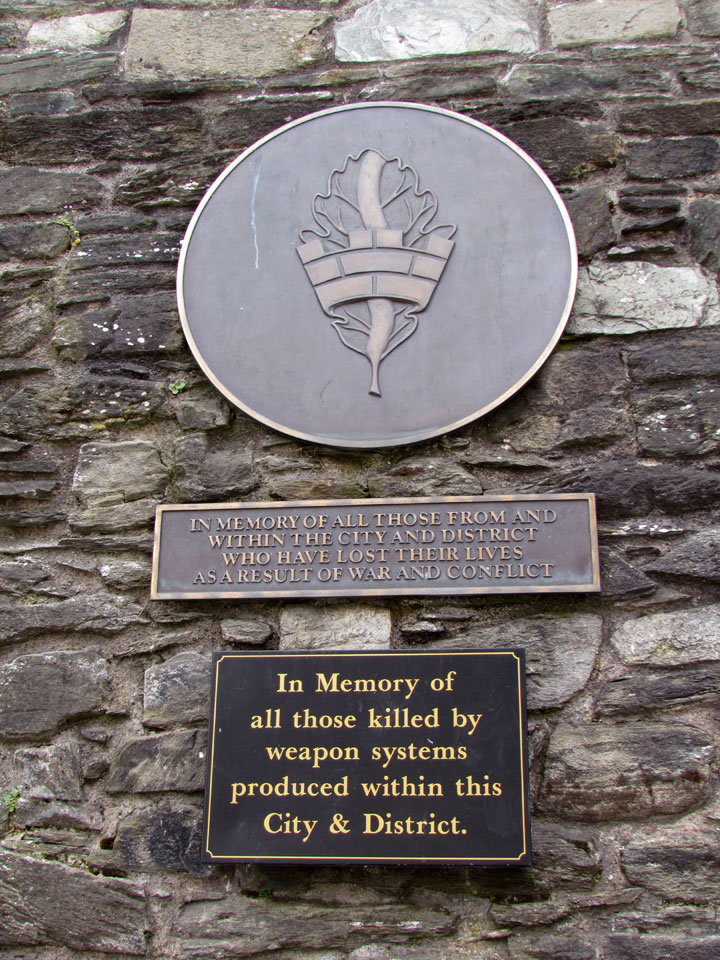
According to the city's Royal Charter of 10 April 1662 the official name is
Londonderry. This was reaffirmed in a High Court decision in January 2007 when
Derry City Council sought guidance on the procedure for effecting a name change.
The council had changed its name from "Londonderry City Council" to "Derry City
Council" in 1984; the court case was seeking clarification as to whether this
had also changed the name of the city. The decision of the court was that it had
not but it was clarified that the correct procedure to do so was via a petition
to the Privy Council. Derry City Council since started the process were involved
in conducting an equality impact assessment report (EQIA). Firstly it held an
opinion poll of district residents in 2009, which reported that 75% of Catholics
and 77% of Nationalists found the proposed change acceptable, compared to 6% of
Protestants and 8% of Unionists. Then the EQIA held two consultative forums, and
solicited comments from the general public on whether or not the city should
have its name changed to Derry. A total of 12,136 comments were received, of
which 3,108 were broadly in favour of the proposal, and 9,028 opposed to it.
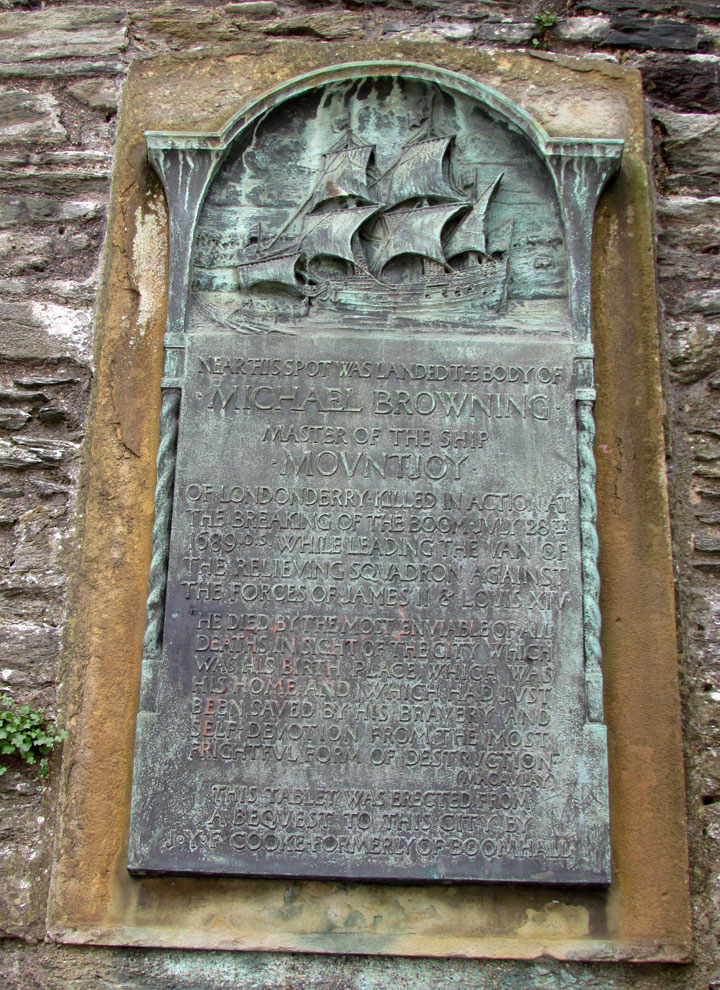
Despite the official name, the city is more usually known as simply Derry, which
is an anglicisation of the old Irish Daire, which in modern Irish is spelt Doire,
and translates as "oak-grove/oak-wood". The name derives from the settlement's
earliest references, Daire Calgaich ("oak-grove of Calgach"). The name was
changed from Derry in 1613 during the Plantation of Ulster to reflect the
establishment of the city by the London guilds.

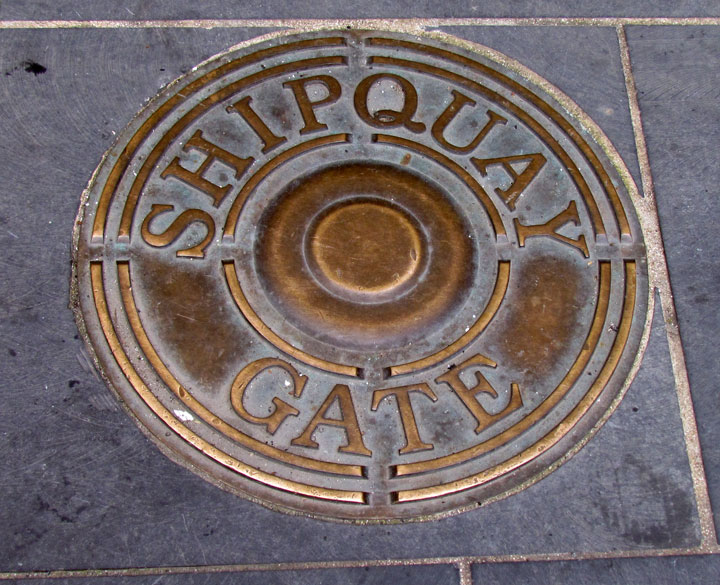
The name "Derry" is preferred by nationalists and it is broadly used throughout Northern Ireland's Catholic community, as well as that of the Republic of Ireland, whereas many unionists prefer "Londonderry"; however in everyday conversation Derry is used by most Protestant residents of the city. Apart from this local government decision, the city is usually known as Londonderry in official use within the UK. In the Republic of Ireland, the city and county are almost always referred to as Derry, on maps, in the media and in conversation. In April 2009, however, the Republic of Ireland's Minister for Foreign Affairs, Micheál Martin, announced that Irish passport holders who were born there could record either Derry or Londonderry as their place of birth. Whereas official road signs in the Republic use the name Derry, those in Northern Ireland bear Londonderry (sometimes abbreviated to L'Derry), although some of these have been defaced with the reference to London obscured. Usage varies among local organisations, with both names being used. Examples are City of Derry Airport, City of Derry Rugby Club, Derry City FC and the Protestant Apprentice Boys of Derry, as opposed to Londonderry Port, Londonderry YMCA Rugby Club and Londonderry Chamber Of Commerce. Most companies within the city choose local area names such as Pennyburn, Rosemount or "Foyle" from the River Foyle to avoid alienating the other community. Londonderry railway station is often referred to as Waterside railway station within the city but is called Derry/Londonderry at other stations. The council changed the name of the local government district covering the city to Derry on 7 May 1984, consequently renaming itself Derry City Council. This did not change the name of the city, although the city is coterminous with the district, and in law the city council is also the "Corporation of Londonderry" or, more formally, the "Mayor, Aldermen and Citizens of the City of Londonderry". The form "Londonderry" is used for the post town by the Royal Mail, however use of Derry will still ensure delivery.

The city is also nicknamed the Maiden City by virtue of the fact that its walls
were never breached during the Siege of Derry in the late 17th century. It is
also nicknamed Stroke City by local broadcaster, Gerry Anderson, due to the
'politically correct' use of the oblique notation Derry/Londonderry (which
appellation has itself been used by BBC Television). A recent addition to the
landscape has been the erection of several large stone columns on main roads
into the city welcoming drivers, euphemistically, to "the walled city".
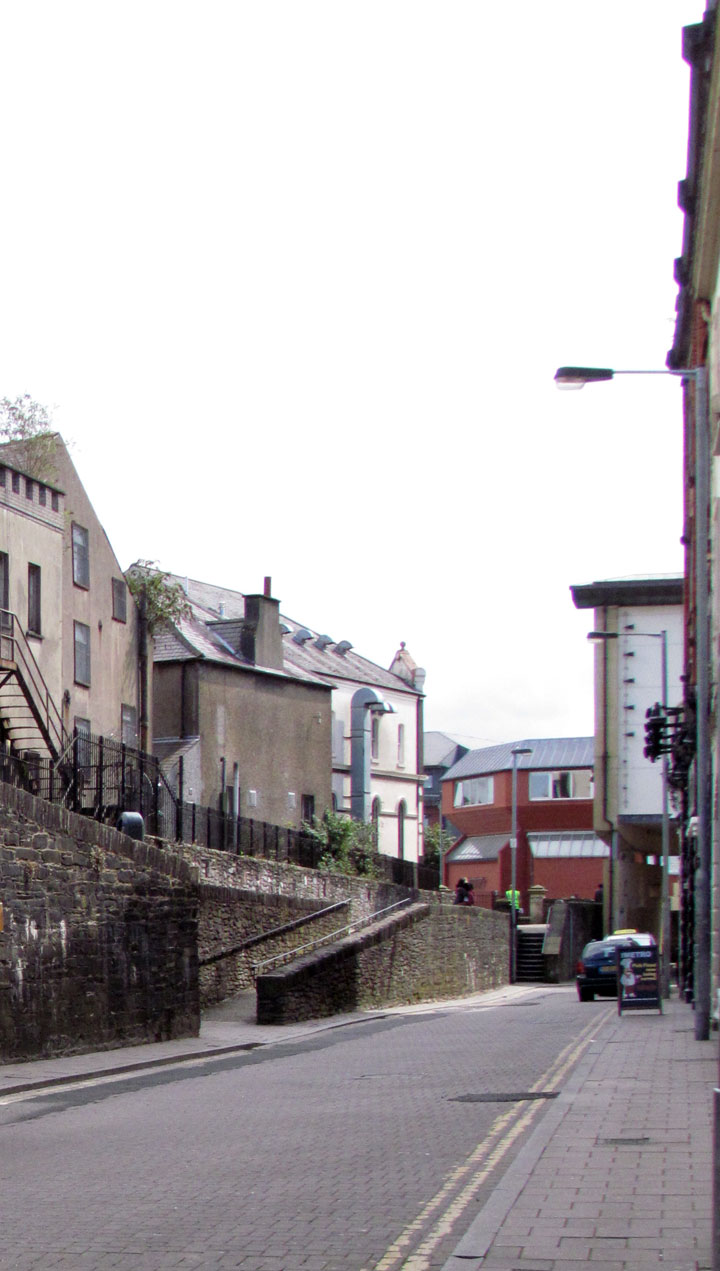
stairway to the wall walk
The name Derry is very much in popular use throughout Ireland for the naming of places, and there are at least six towns bearing that name and at least a further 79 places. The word Derry often forms part of the place name, for example Derrymore, Derrybeg and Derrylea.

Derry is the only remaining completely intact walled city in Ireland and one of
the finest examples of a walled city in Europe. The walls constitute the largest
monument in State care in Northern Ireland and, as the last walled city to be
built in Europe, stands as the most complete and spectacular.
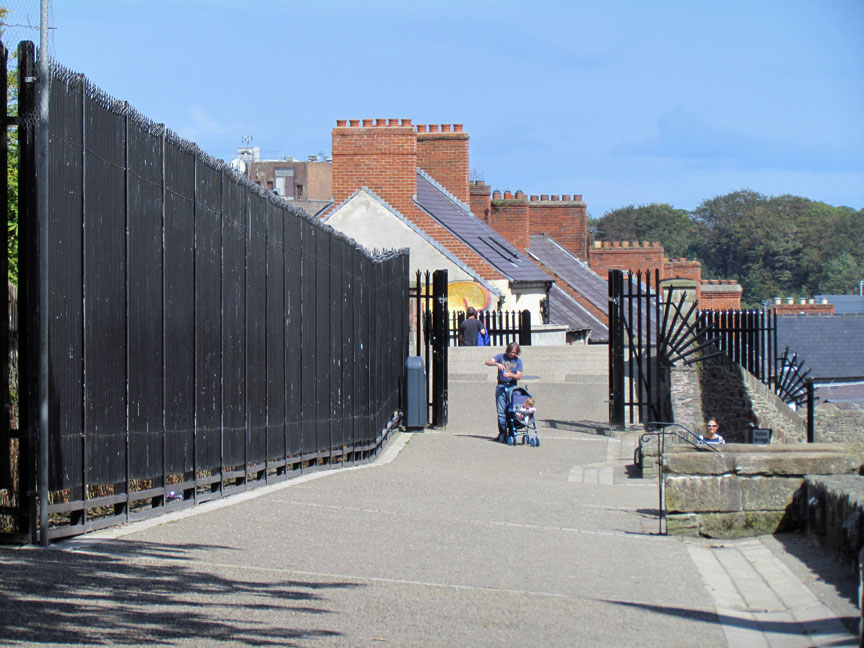
The Walls were built during the period 1613-1619 by The Honourable The Irish
Society as defences for early 17th century settlers from England and Scotland.
The Walls, which are approximately 1 mile (1.5 km) in circumference and which
vary in height and width between 12 and 35 feet (4 to 12 metres), are completely
intact and form a walkway around the inner city. They provide a unique promenade
to view the layout of the original town which still preserves its Renaissance
style street plan. The four original gates to the Walled City are Bishop’s Gate,
Ferryquay Gate, Butcher Gate and Shipquay Gate to which three further gates were
added later, Magazine Gate, Castle Gate and New Gate, making seven gates in
total. Historic buildings within the walls include the 1633 Gothic cathedral of
St Columb, the Apprentice Boys Memorial Hall and the courthouse.

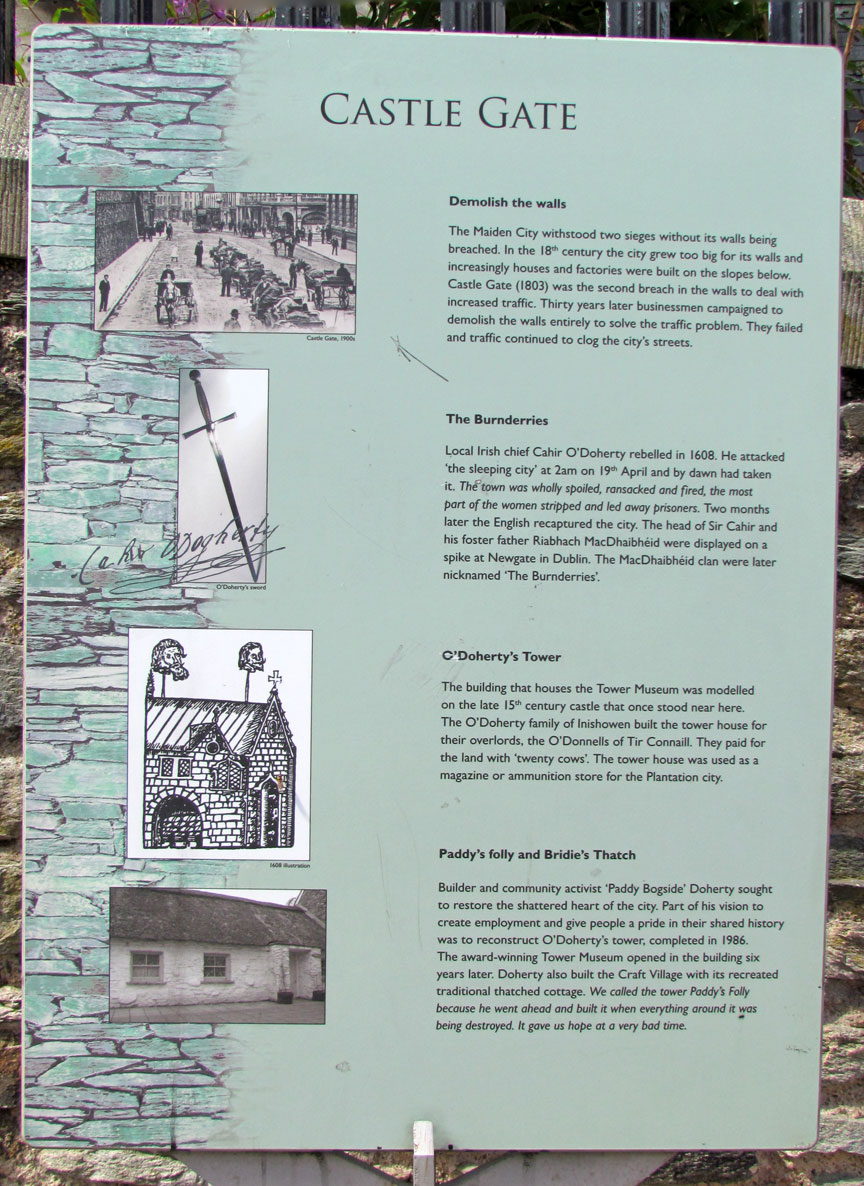
It is one of the few cities in Europe that never saw its fortifications
breached, withstanding several sieges including one in 1689 which lasted 105
days, hence the city's nickname, The Maiden City.
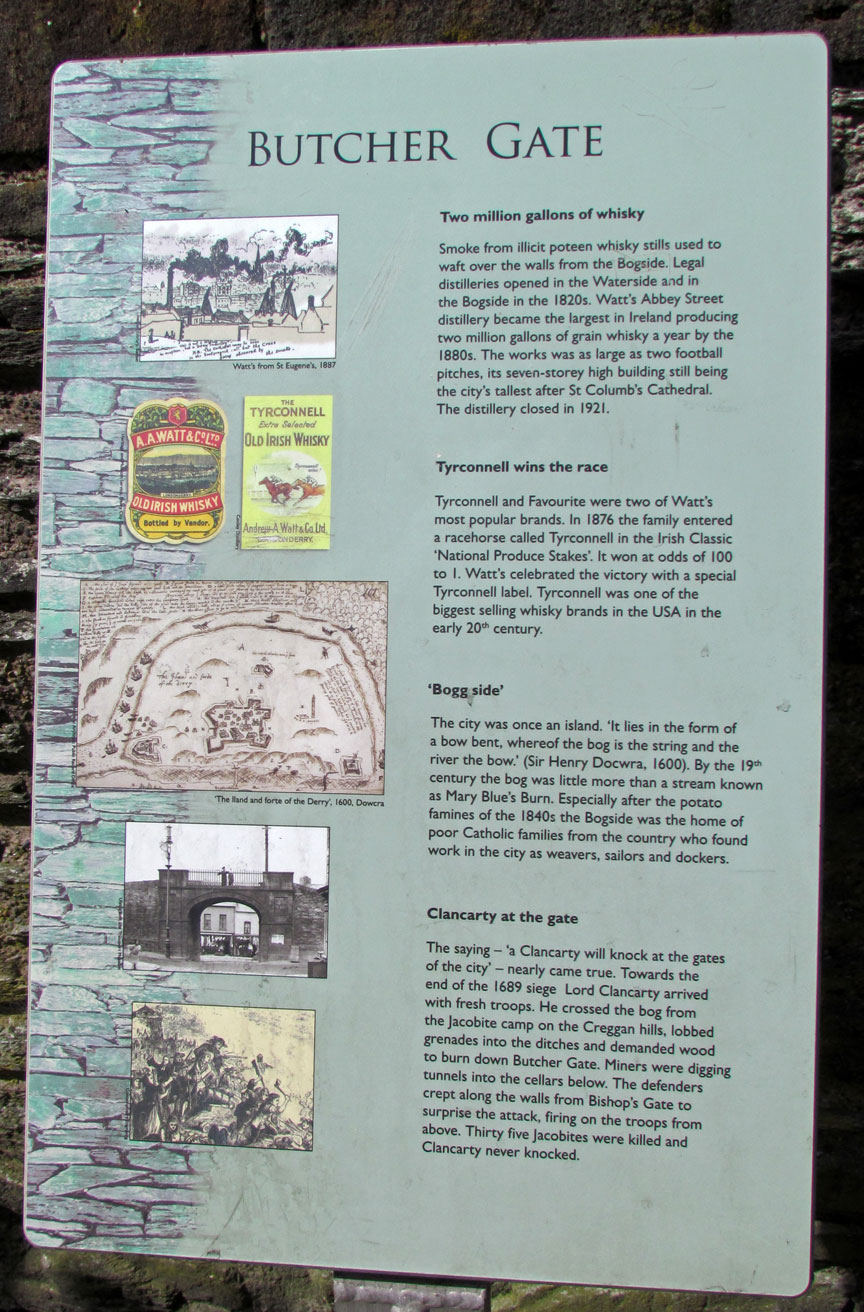
The city has long been a focal point for important events in Irish history,
including the 1688-1689 siege of Derry and Bloody Sunday on 30 January 1972.
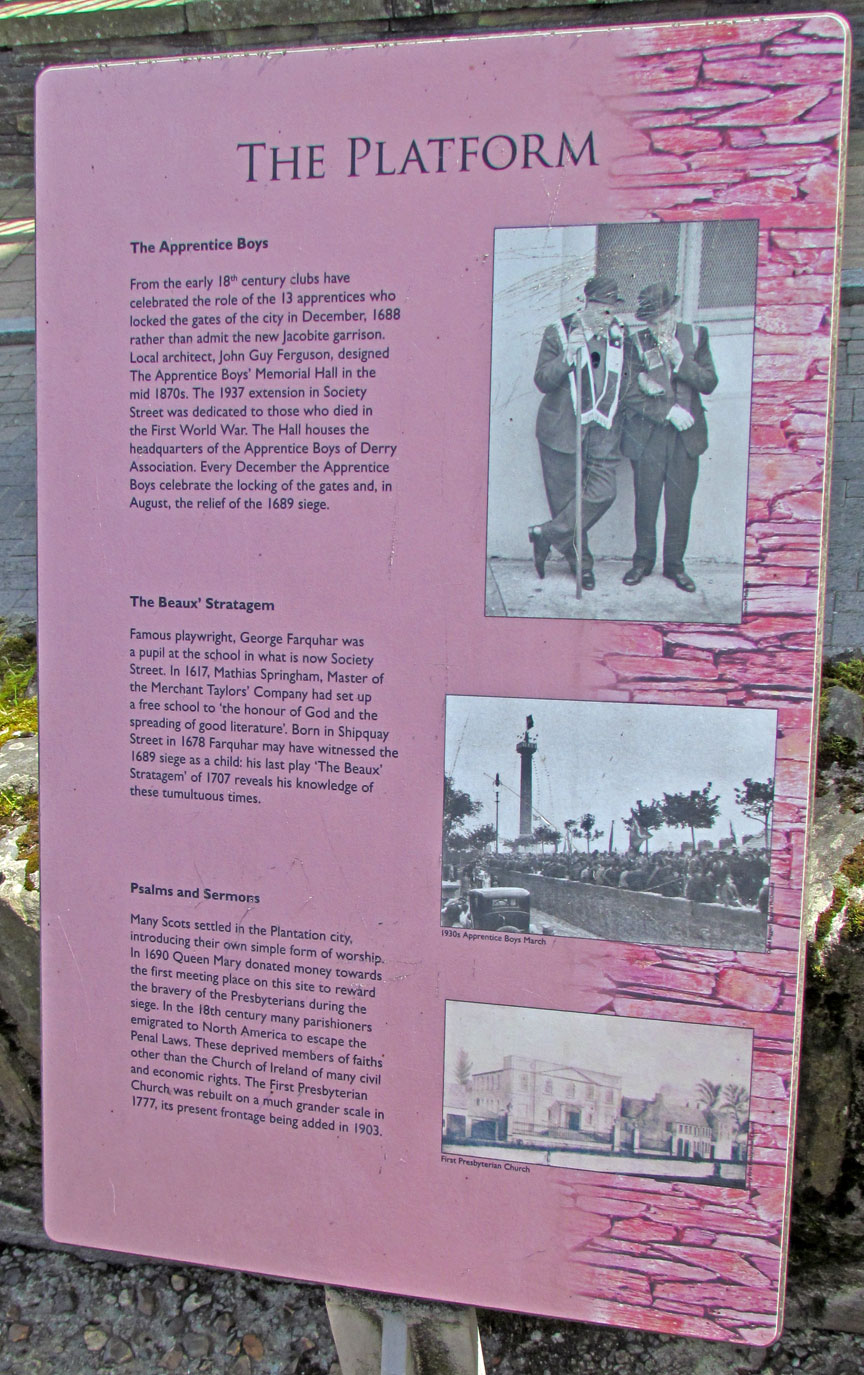
Derry is one of the oldest continuously inhabited places in Ireland. The
earliest historical references date to the 6th century when a monastery was
founded there by St. Columba or Colmcille, a famous saint from what is now
County Donegal, but for thousands of years before that people had been living in
the vicinity.
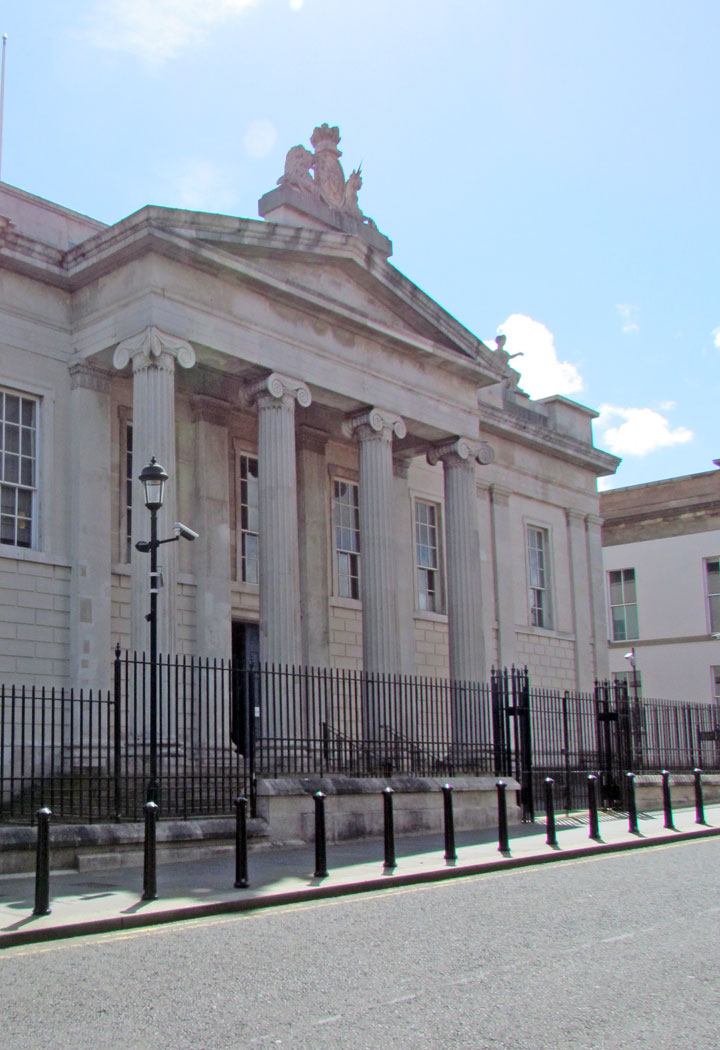
Before leaving Ireland to spread Christianity elsewhere, Columba founded a
monastery in the then Doire Calgach, on the east side of the Foyle. According to
oral and documented history, the site was granted to Columba by a local king.
The monastery then remained in the hands of the federation of Columban churches
who regarded Colmcille as their spiritual mentor. The year 546 is often referred
to as the date that the original settlement was founded. However it is accepted
that this was an erroneous date assigned by medieval chroniclers. It is
accepted that between the 6th century and the 11th century, Derry was known
primarily as a monastic settlement.
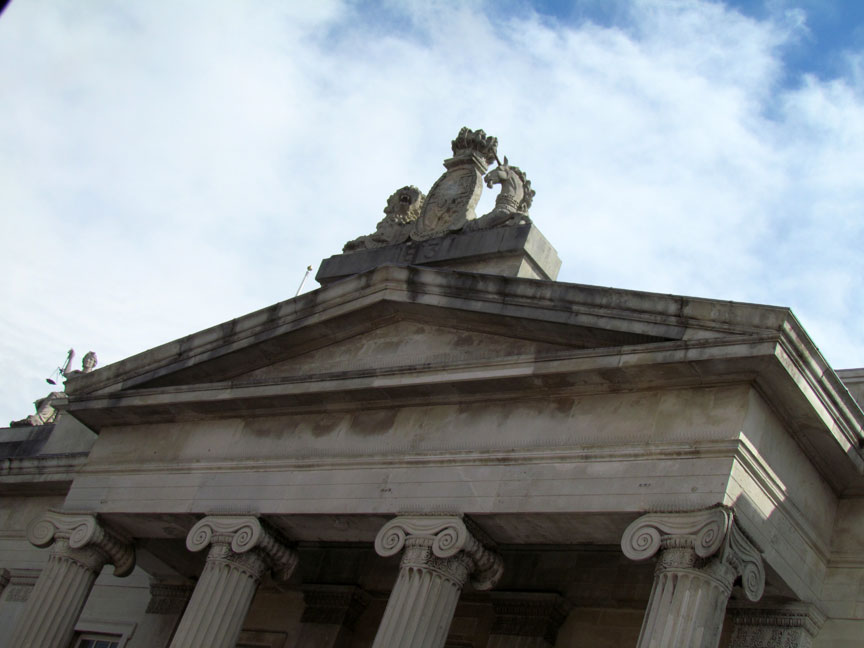
The town became strategically more significant during the Tudor conquest of
Ireland and came under frequent attack, until in 1608 it was destroyed by Cahir
O'Doherty, Irish chieftain of Inishowen.
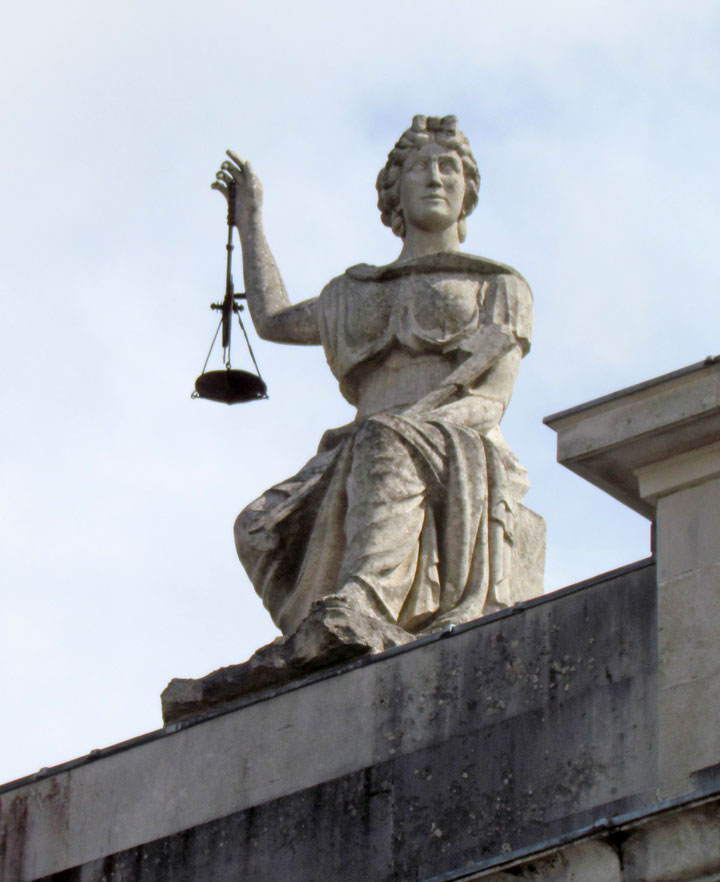
Planters organised by London livery companies through The Honourable The Irish
Society arrived in the 17th century as part of the plantation of Ulster, and
built the city of Londonderry across the Foyle from the earlier town, with walls
to defend it from Irish insurgents who did not welcome the occupation. The aim
was to settle Ulster with a population supportive of the Crown.
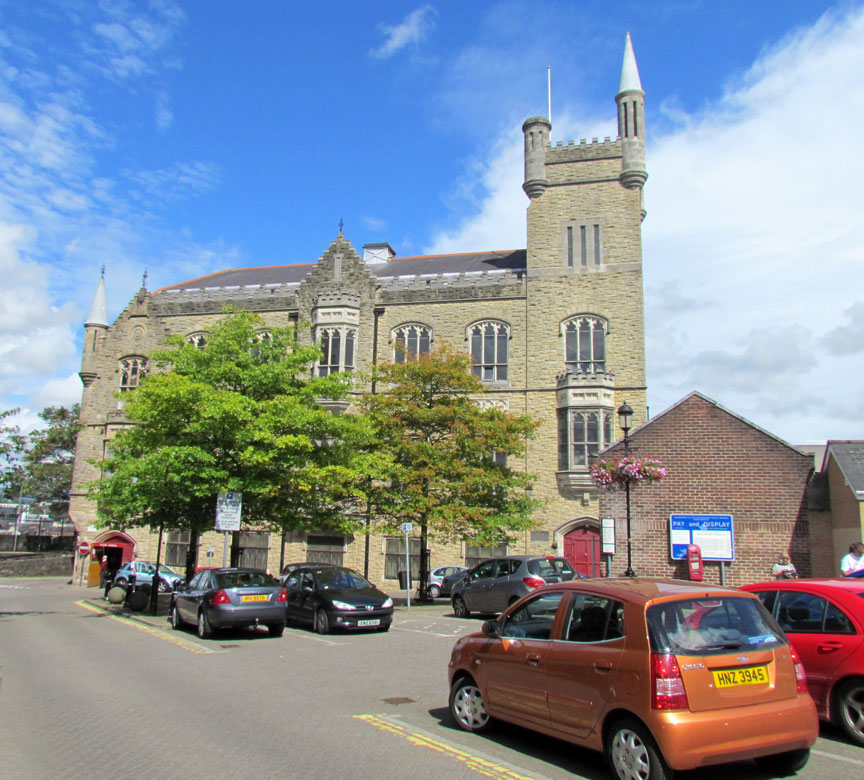
This Derry was the first planned city in Ireland: it was begun in 1613, with the
walls being completed 5 years later in 1618, at a cost of £10,757. The central
diamond within a walled city with four gates was thought to be a good design for
defence. The grid pattern chosen was subsequently much copied in the colonies of
British North America. The charter initially defined the city as extending three
Irish miles (about 6.1 km) from the center.
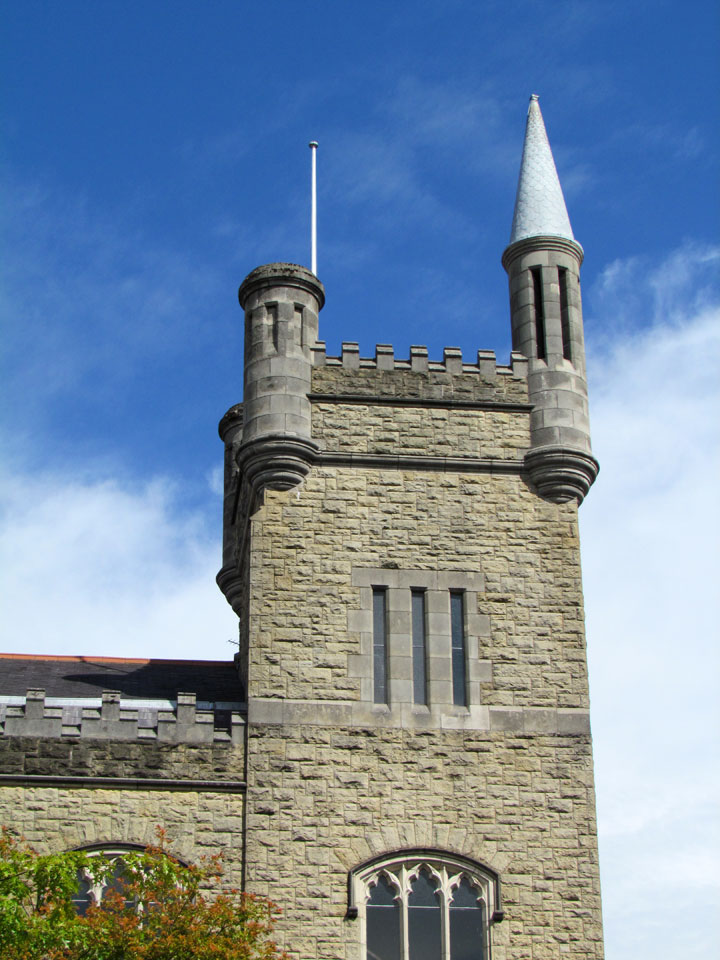
The modern city preserves the 17th century layout of four main streets radiating
from a central Diamond to four gateways — Bishop's Gate, Ferryquay Gate,
Shipquay Gate and Butcher's Gate. The city's oldest surviving building was also
constructed at this time: the 1633 Plantation Gothic cathedral of St Columb. In
the porch of the cathedral is a stone that records completion with the
inscription: "If stones could speake, then London's prayse should sound, Who
built this church and cittie from the grounde."
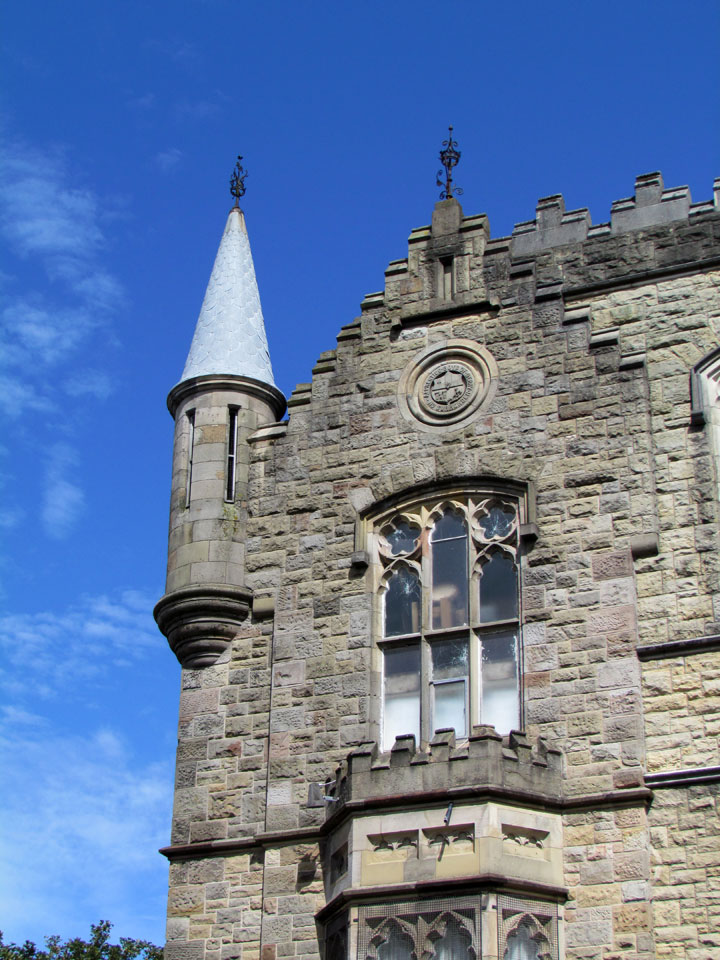
During the 1640s, the city suffered in the Wars of the Three Kingdoms, which
began with the Irish Rebellion of 1641, when the Gaelic Irish insurgents made a
failed attack on the city. In 1649 the city and its garrison, which supported
the republican Parliament in London, were besieged by Scottish Presbyterian
forces loyal to King Charles I. The Parliamentarians besieged in Derry were
relieved by a strange alliance of Roundhead troops under George Monck and the
Irish Catholic general Owen Roe O'Neill. These temporary allies were soon
fighting each other again however, after the landing in Ireland of the New Model
Army in 1649. The war in Ulster was finally brought to an end when the
Parliamentarians crushed the Irish Catholic Ulster army at the battle of
Scarrifholis in nearby Donegal in 1650.
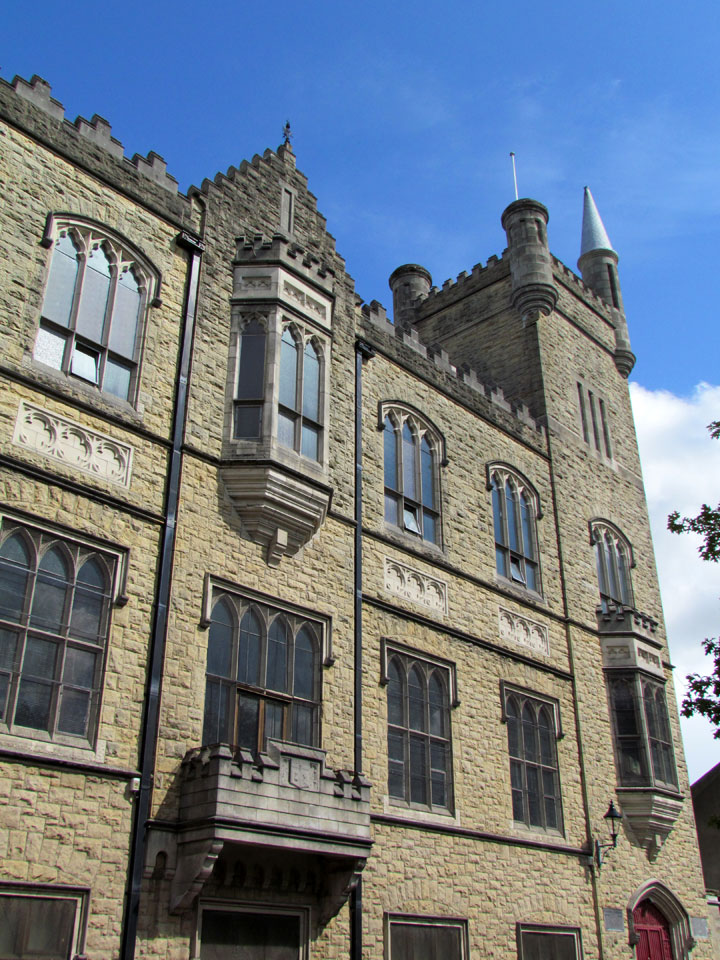
During the Glorious Revolution, only Derry and nearby Enniskillen had a
Protestant garrison by November 1688. An army of around 1,200 men, mostly
"Redshanks" (Highlanders), under Alexander Macdonnell, 3rd Earl of Antrim, was
slowly organised (they set out on the week William of Orange landed in England).
When they arrived on 7 December 1688 the gates were closed against them and the
Siege of Derry began. In April 1689, King James came to the city and summoned it
to surrender. The King was rebuffed and the siege lasted until the end of July
with the arrival of a relief ship.
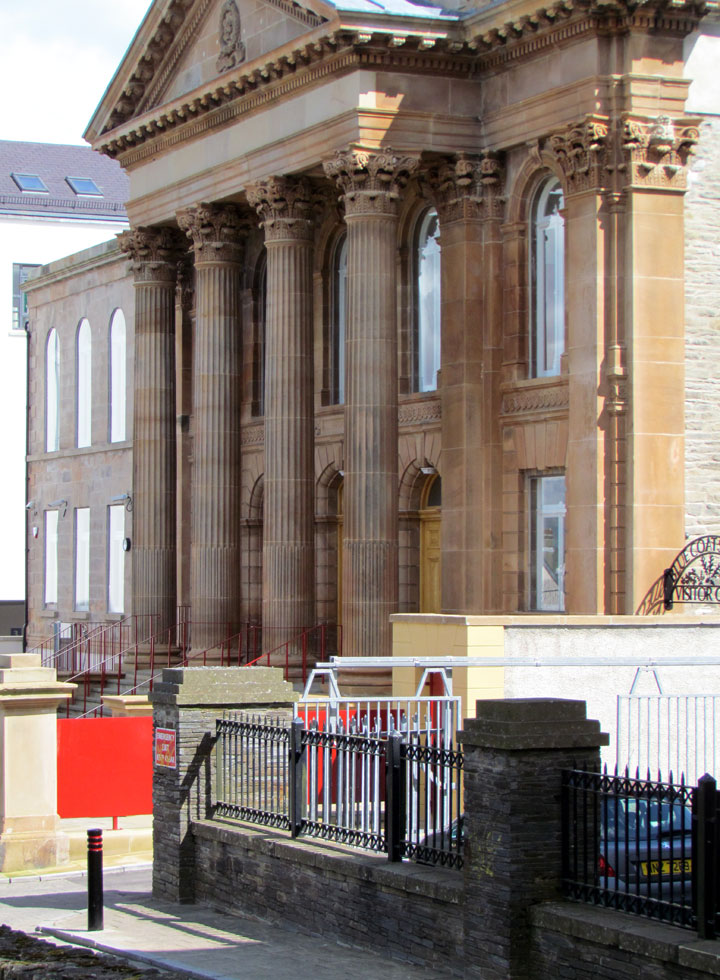
The city was rebuilt in the 18th century with many of its fine Georgian style
houses still surviving. The city's first bridge across the River Foyle was built
in 1790. During the 18th and 19th centuries the port became an important
embarkation point for Irish emigrants setting out for North America. Some of
these founded the colonies of Derry and Londonderry in the state of New
Hampshire.
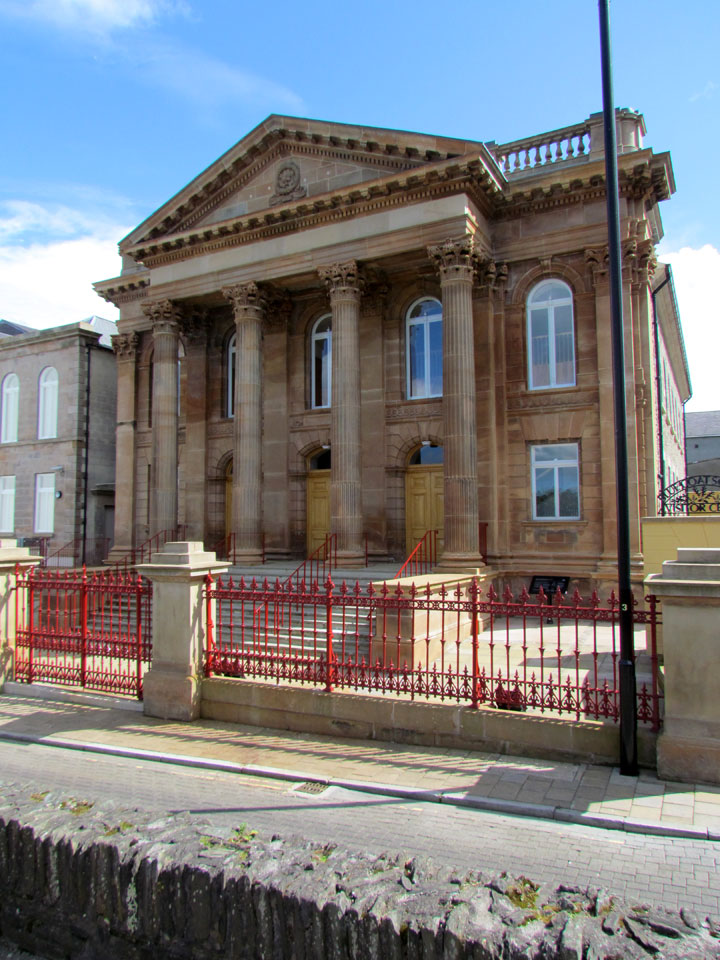
Also during the 19th century, it became a destination for migrants fleeing areas
more severely affected by the Irish Potato Famine. One of the most notable
shipping lines was the McCorkell Line operated by Wm. McCorkell & Co. Ltd. from
1778. The McCorkell's most famous ship was the Minnehaha, which was known as the
"Green Yacht from Derry".
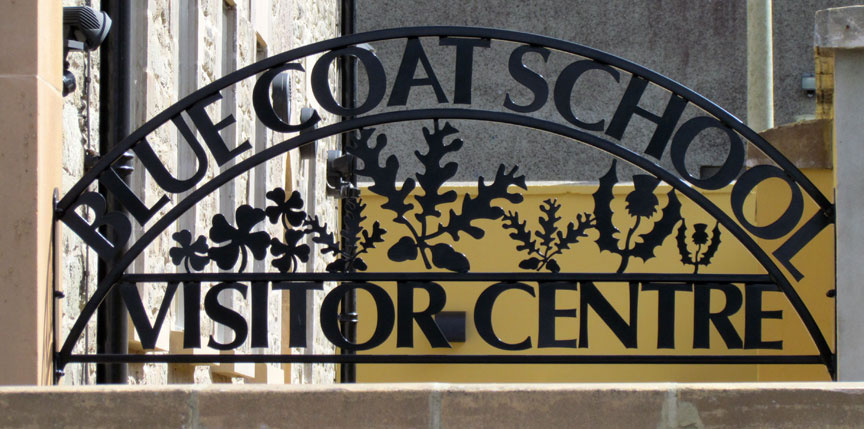
During the Irish War of Independence, the area was rocked by sectarian violence,
partly prompted by the guerilla war raging between the Irish Republican Army and
British forces, but also influenced by economic and social pressures. By mid
1920 there was severe sectarian rioting in the city. Many lives were lost and in
addition many Catholics and Protestants were expelled from their homes during
this communal unrest. After a week's violence, a truce was negotiated by local
politicians on both unionist and republican sides.
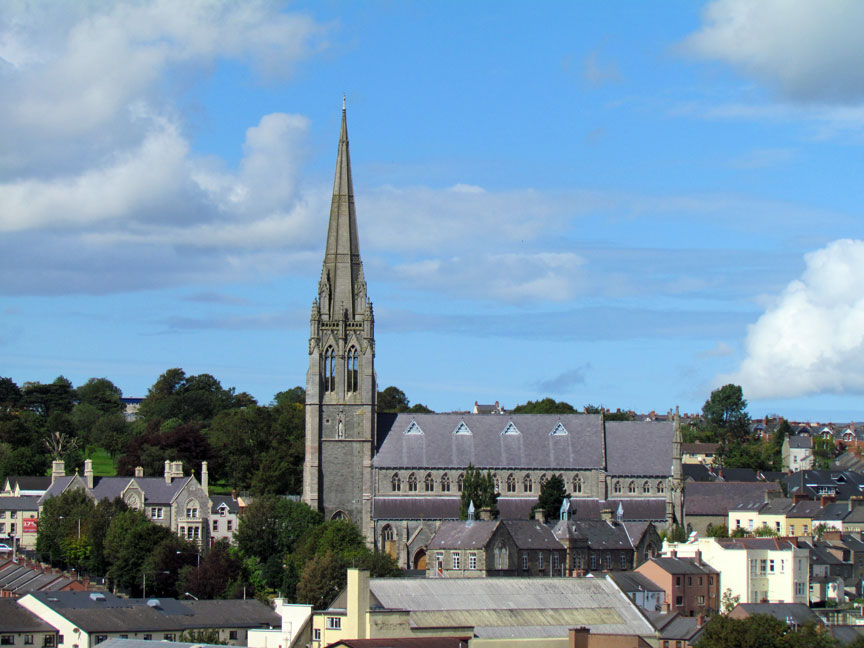
In 1921, following the Anglo-Irish Treaty and the partition of Ireland, it
unexpectedly became a border city, separated from much of its traditional
economic hinterland in County Donegal.
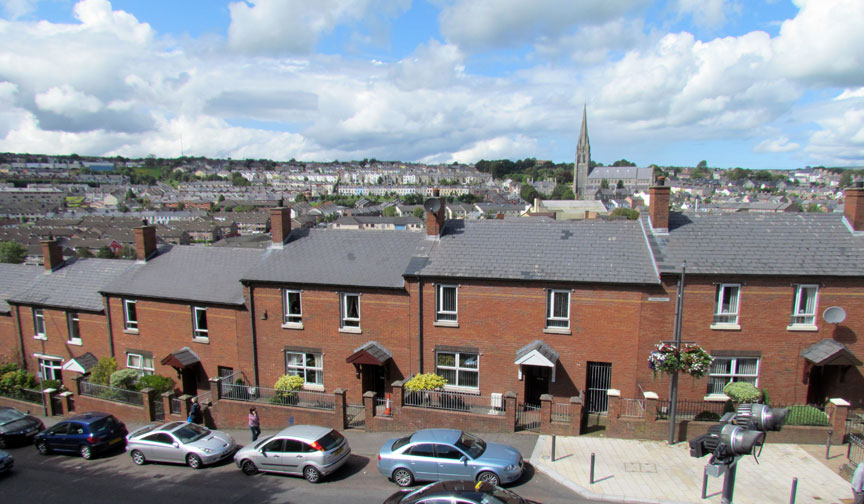
During the Second World War the city played an important part in the Battle of
the Atlantic. Ships from the Royal Navy, the Royal Canadian Navy, and other
Allied navies were stationed in the city and the United States military
established a base. The reason for such a high degree of military and naval
activity was self-evident: Derry was the United Kingdom's westernmost port;
indeed, the city was the westernmost Allied port in Europe: thus, Derry was a
crucial jumping-off point, together with Glasgow and Liverpool, for the shipping
convoys that ran between Europe and North America. The large numbers of military
personnel in Derry substantially altered the character of the city, bringing in
some outside colour to the local area, as well as some cosmopolitan and economic
buoyancy during these years. At the conclusion of the Second World War,
eventually some 60 U-boats of the German Kriegsmarine ended in the city's
harbour at Lisahally after their surrender.
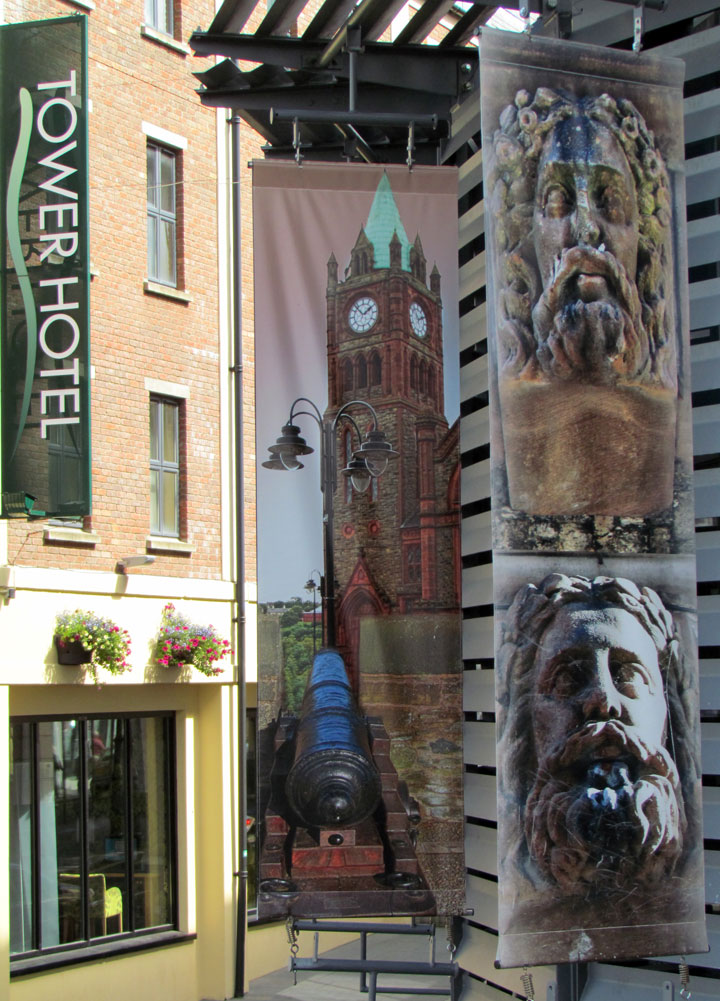
Catholics were discriminated against under Unionist government in Northern
Ireland, both politically and economically. In the late 1960s the city became
the flashpoint of disputes about institutional gerrymandering.

All the accusations of gerrymandering, practically all the complaints about
housing and regional policy, and a disproportionate amount of the charges about
public and private employment come from this area. The area – which consisted of
Counties Tyrone and Fermanagh, Londonderry County Borough, and portions of
Counties Londonderry and Armagh - had less than a quarter of the total
population of Northern Ireland yet generated not far short of three-quarters of
the complaints of discrimination...The unionist government must bear its share
of responsibility. It put through the original gerrymander which underpinned so
many of the subsequent malpractices, and then, despite repeated protests, did
nothing to stop those malpractices continuing. The most serious charge against
the Northern Ireland government is not that it was directly responsible for
widespread discrimination, but that it allowed discrimination on such a scale
over a substantial segment of Northern Ireland.
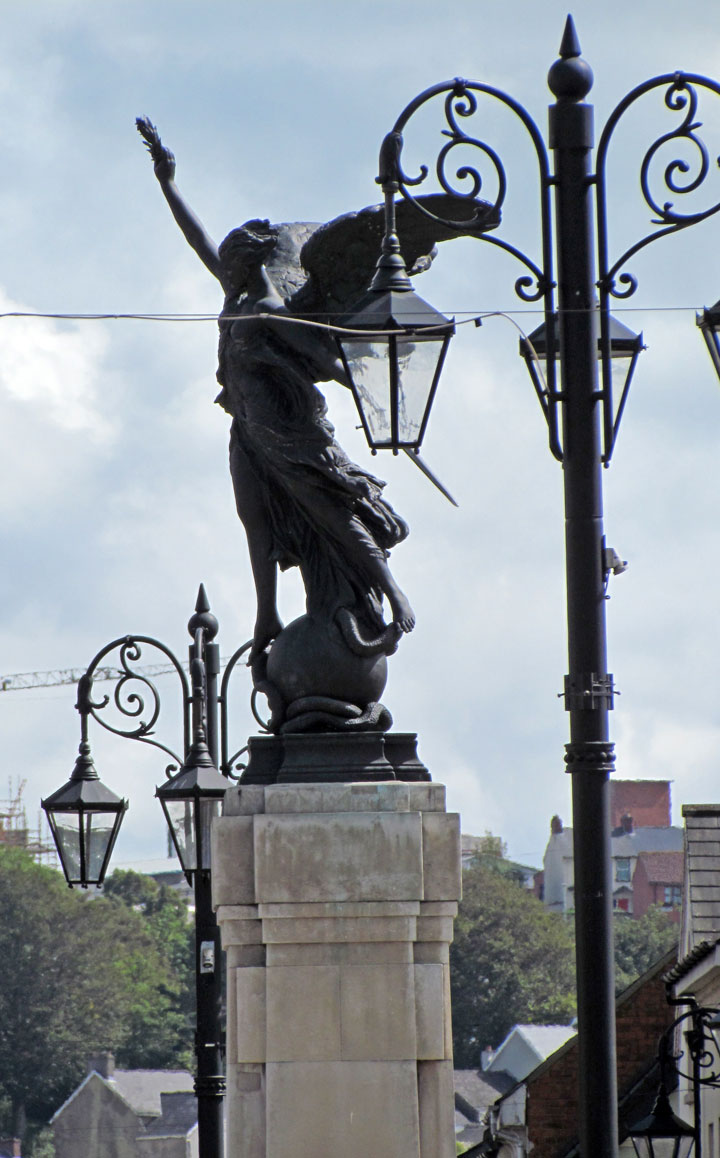
A civil rights demonstration in 1968 led by the Northern Ireland Civil Rights
Association was banned by the Government and blocked using force by the Royal
Ulster Constabulary. The events that followed the August 1969 Apprentice Boys
parade resulted in the Battle of the Bogside, when Catholic rioters fought the
police, leading to widespread civil disorder in Northern Ireland and is often
dated as the starting point of the Troubles.
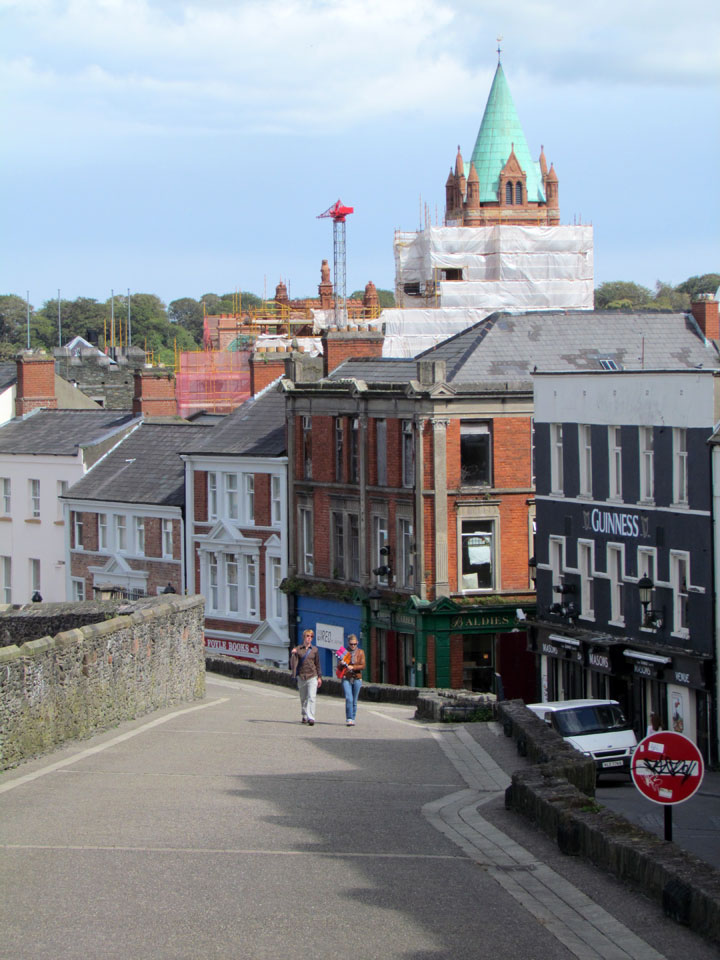
On Sunday January 30, 1972, 13 unarmed civilians were shot dead by British
paratroopers during a civil rights march in the Bogside area. Another 13 were
wounded and one further man later died of his wounds. This event came to be
known as Bloody Sunday.

renovation required
Violence eased towards the end of the Troubles in the late 1980s and early 1990s. Irish journalist Ed Maloney claims in "The Secret History of the IRA" that republican leaders there negotiated a de facto ceasefire in the city as early as 1991. Whether this is true or not, the city did see less bloodshed by this time than Belfast or other localities.
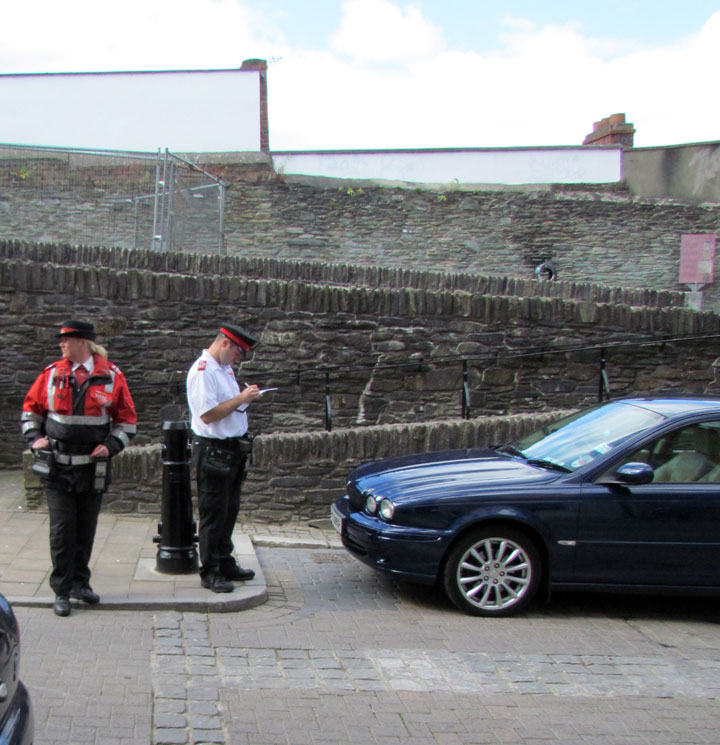
parked in the wrong location
The city was visited by a killer whale in November 1977 at the height of the Troubles; it was dubbed Dopey Dick by the thousands who came from miles around to see him.
Text from Wikipedia
